Intel Launches Overclockable Xeon W CPUs up to 56 Cores: a Return to HEDT-Class Chips
They're pricey, but HEDT-class chips are back.
Intel announced its Xeon W-3400 and W-2400 workstation processors, codenamed Fishawk Falls, with 15 new chips spanning from the flagship 56-core $5,889 Xeon w-3495X to the eight-core $359 w3-2423. Eight of the new models are also overclockable, thus marking Intel's return to HEDT-class desktop processors (lower-cost overclockable server processors) for the first time since it launched the Core i9-10980XE back in 2019 and then abandoned the HEDT segment to AMD.
AMD's competing Threadripper Pro currently holds the top spots on our list of best CPUs for workstations and still has the core count lead with the 64-core Threadripper Pro 5995WX. However, Intel's support for the latest connectivity options, including up to 112 PCIe 5.0 lanes and eight channels of DDR5 memory while AMD still relies on PCIe 4.0 and DDR4, could give it the edge in some workloads.
Intel claims the new Xeon W chips are up to 28% faster in single-threaded and 120% faster in multi-threaded work than its own previous-gen Xeon W processors, but didn't share any performance comparisons to AMD's Threadripper Pro series processors that address the same core workstation market segments. Intel also didn't share any gaming performance benchmarks to give us a sense of where these chips will land on the list of the best CPUs for gaming. This makes sense, given the workstation focus, but the chips' overclockability will make game testing results interesting once the silicon is in the wild.
Intel Xeon W-3400 W-2400 Specifications and Pricing
| Row 0 - Cell 0 | Cores / Threads | MSRP/SEP | Base / Boost (GHz) | TDP | PCIe | L3 Cache (MB) |
| Threadripper Pro 5995WX | 64 / 128 | $6,499 | 2.7 / 4.5 | 280W | 128 | 256 (8CCD + I/OD) |
| Xeon w9-3495X | 56 / 112 | $5,889 | 1.9 / 4.8 | 350W | 112 | 105 |
| Xeon w9-3475X | 36 / 72 | $3,739 | 2.2 / 4.8 | 300W | 112 | 82.5 |
| Threadripper Pro 5975WX | 32 / 64 | $3,299 | 3.6 / 4.5 | 280W | 128 | 128 (4CCD + I/OD) |
| Xeon w7-3455 | 24 / 48 | $2,489 | 2.5 / 4.8 | 270W | 112 | 75 |
| Threadripper Pro 5965WX | 24 / 48 | $2,399 | 3.8 / 4.5 | 280W | 128 | 128 (4CCD + I/OD) |
| Intel Xeon w5-3435X | 16 / 32 | $1,589 | 3.1 / 4.7 | 270W | 112 | 45 |
| Threadripper 5955WX | 16 / 32 | OEM-only | 4.0 / 4.5 | 280W | 128 | 64 |
Here's a quick comparison of a few of Intel's flagship chips to AMD's competing Threadripper Pro. Intel's workstation family includes four tiers with w9, w7, w5, and w3 models, mostly analogous to Intel's Core i9, i7, i5, and i3 branding scheme. Intel carves the Xeon W stack into four tiers, including dual socket models. We'll dive into the families in more detail below, but the single-socket W-2400 and W-3400 tiers are the focus of this launch:
- Intel Xeon W-3400: "Expert," 12 to 56 hyperthreaded cores, 112 Lanes PCIe 5.0 from CPU, Eight Channels up to DDR5-4800 (4TB), 270W to 350W (w5, w7, w9), single LGA-4677 socket, W790 chipset
- Intel Xeon W-2400: "Mainstream," 6 to 24 hyperthreaded cores, 64 Lanes PCIe 5.0 from CPU, Four Channels up to DDR5-4800 (2TB), 120W to 225W (w3, w5, w7), single LGA-4677 socket, W790 chipset
- Maximum Turbo Power (MTP) is 1.2X the Processor Base Power (PBP)
The processors wield Intel's Golden Cove architecture and use the same design as the fourth-gen Xeon Scalable server processors, which are also known as Sapphire Rapids. The W-3400 processors come with the multi-chiplet XCC Sapphire Rapids design, while the W-2400 processors use a single MCC die.
The Golden Cove architecture is also found in Intel's consumer-oriented Alder Lake and marks a big step forward from the Sunny Cove cores found in the previous-gen Ice Lake Xeon processors. Notably, the new Xeon W processors only have large performance cores, so there are no smaller e-cores like we see with Intel's hybrid processors for mainstream desktop PCs.
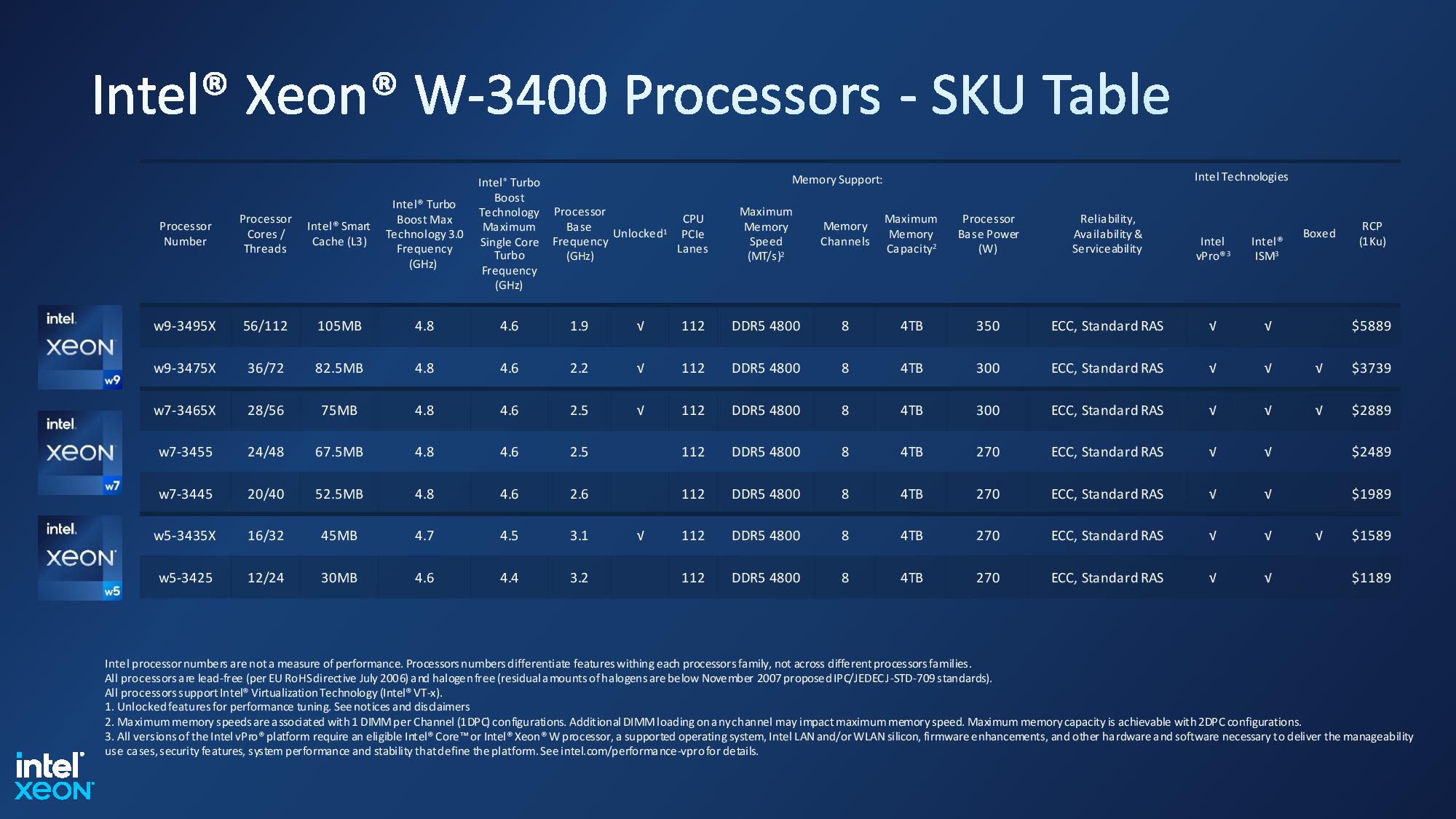

Here we can see the broader lineup of Intel's processors, but you'll notice that only seven of the 15 models are available at retail as a boxed unit — you'll have to buy a complete OEM system if you want many of these models. Additionally, only seven of the models are overclockable, and the overclockable 56-core flagship isn't available at retail.
The Xeon-W lineup spans from $350 to $5,889, but direct per-core pricing comparisons to the desktop Raptor Lake processors are tricky, given that those models all come with smaller e-cores that aren't as performant but skew the pricing metrics. Intel's Xeon W pricing is generally in the same range as the competing Threadripper Pro processors' suggested pricing, but we'll have to see how pricing settles when the processors arrive at retail.
Boost clocks range from 4.8 GHz on the highest-end models to 4.2 GHz at the end of the stack with the eight-core w3-2423. Intel's new chips have significant increases in cache compared to their predecessors (breakdown here), with up to 105MB available with the flagship model. Intel lists Processor Base Power (PBP), which is similar to the TDP rating, as stretching from 270W to 350W for the W-3400 series and 120W to 225W for the W-2400 series. These chips will consume more power under full load at their Maximum Turbo Power (MTP) rating, which is 1.2X the PBP. (For instance, the 350W model will peak at 420W, while the 300W model will reach 360W.)
Xeon W supports either 112 or 64 lanes of PCIe 5.0, depending upon the model, which provides twice the throughput of PCIe 4.0. Intel's support for DDR5 provides twice the memory throughput of DDR4, but it could also be a limiting factor for now — DDR5 continues to command hefty premiums over DDR4 memory.
The Xeon W processors support up to DDR5-4800 with one DIMM per channel (1DPC) and drop to DDR5-4400 for 2DPC, which is an important factor for workstation processors. Additionally, the w3 SKUs run at DDR5-4400 with 1DPC. Memory capacity tops out at 4TB for the W-3400 models and 2TB for W-2400, a significant jump over the 128GB limit for Intel's mainstream desktop PC processors.
AMD's Threadripper Pro 5000-series processors currently leverage the company's previous-gen Zen 3 architecture, so they are still limited to DDR4 memory and PCIe 4.0. We expect that AMD will have its own new workstation processors with the Zen 4 architecture available in due time, thus matching Intel on the connectivity front, but we don't know when those processors will launch.
Intel's Xeon W processors all support AVX-512, Deep Leaning Boost (DLBoost), and the new Advanced Matrix Extensions (AMX) instructions (INT8 and BFLoat 16) that deliver explosive performance uplift in AI workloads by using a new set of two-dimensional registers called tiles. Intel's AMX implementation is primarily used to boost performance in AI training and inference operations.
Intel Xeon W-3400 W-2400 Overclocking
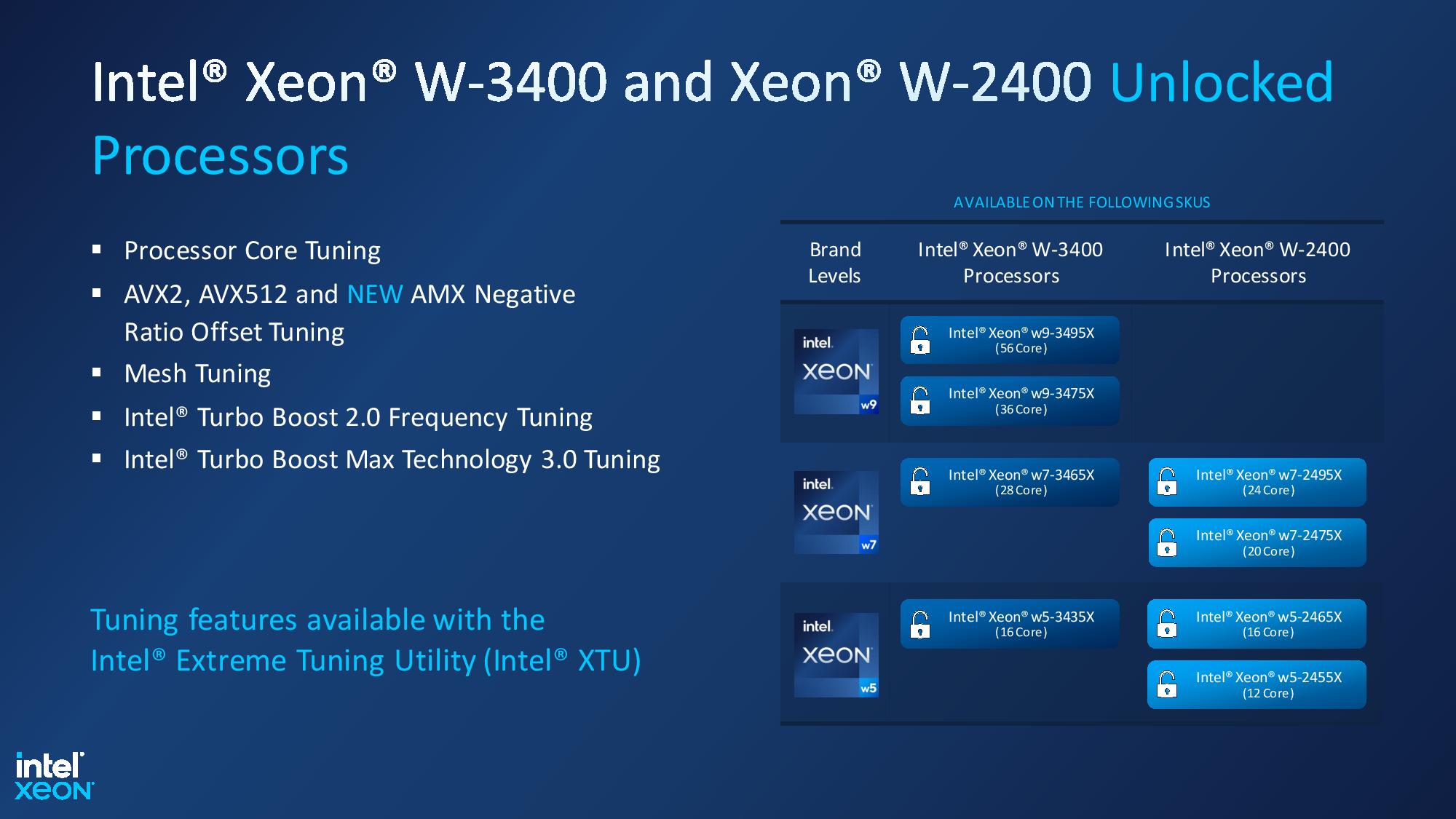
Select Xeon W models support overclocking both the cores and fabric, which Intel positions as useful for professionals that need the utmost performance but can tolerate potential instability (high frequency trading comes to mind), but this has long been one of the defining features of the enthusiast-focused HEDT segment. Just as we've seen with past HEDT processors, the Xeon W lineup is comprised of overclockable server chips. However, pricing is much like we see with AMD's Threadripper Pro — far above what we would deem to be rational for most enthusiasts.
Intel's minimum bar for an overclockable model you can buy at retail is $1,039 for the 12-core w5-2445 and progresses up to $3,739 for the 36-core w9-3475X. This is expensive given the core counts, but it is a lower bar for entry than we see with AMD's Threadripper Pro lineup, which has a minimum pricing bar of $2,399 and an expensive motherboard ecosystem.
Regardless of the class of Xeon W chip you chose, you'll have to factor in expensive platform pricing that can ruin the value prop for the Xeon W family as an HEDT platform — particularly with the W-3400 series due to its eight channels of DDR5 support, which adds cost to both the motherboards and memory. That makes the W-2400 the most accessible for enthusiasts and prosumers with its quad-channel memory support, but motherboard pricing will remain stiff due to the nature of workstation-class platforms.
The overclockable w-2400 processors start at the $1,039 12-core w5-2455X and stretch up to the $2,189 24-core w7-2495X. Naturally, those prices are hard to stomach when AMD has the 16-core Ryzen 9 7950X with a full complement of performance cores on offer for $600, so those looking for an HEDT-class system will be attracted more to the workstation-class features, like the increased number of PCIe lanes and support for ECC memory.
Naturally, these costs aren't as much of a concern for workstation users, as these machines are often business assets that generate revenue. Despite Intel's lower pricing for an entry-level HEDT-class chip, it remains to be seen if these will be viable as an HEDT-class lineup for enthusiasts because direct comparisons with Intel's desktop PC chips are hard due to their hybrid architecture, and Ryzen processors have an entirely different architecture. As such, we'll have to put these chips to the test to gauge the price-to-performance ratio.
Xeon W's core multipliers are fully unlocked, meaning you can overclock the cores at will, but BCLK adjustments aren't allowed (we're digging for details on why that limitation exists). As with the desktop processors, Intel has AVX2 and AVX-512 offsets that downshift the overclocked chip frequency when processing those types of instructions to ensure that the system remains stable in the most intense workloads, but Intel has also added a new AMX offset for Advanced Matrix Extensions. There are also accommodations for mesh frequency adjustments and turbo ratio overclocking.
Intel added support for XMP 3.0 one-click memory overclocking profiles. Overclocking the memory via XMP profiles is of little risk but can impart big memory throughput gains, so we imagine this will be popular for those with throughput-hungry workloads. All of the overclocking features are available in Intel's software-based Extreme Tuning Utility (XTU), but overclocking options will also be available in the BIOS.
Intel's support for overclocking comes with all of the typical caveats, such as the fact that it can shorten the chip's lifespan and voids the warranty. While Intel's addition of overclocking for these processors is enticing for enthusiasts, the high pricing of the chips, motherboards, cooling, and DDR5 memory will surely limit its appeal.
Intel Xeon W-3400 W-2400 Platform and Cooling

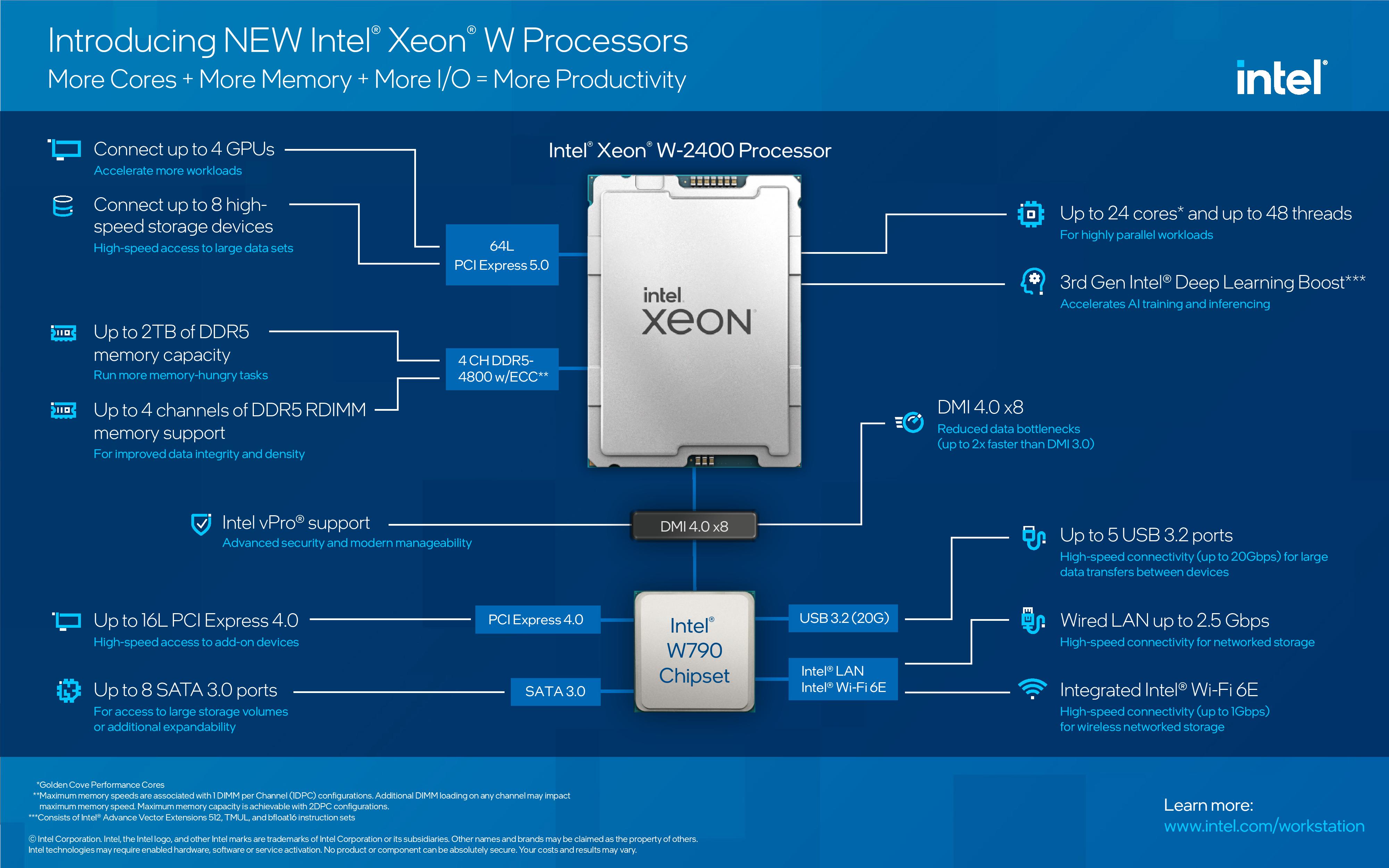
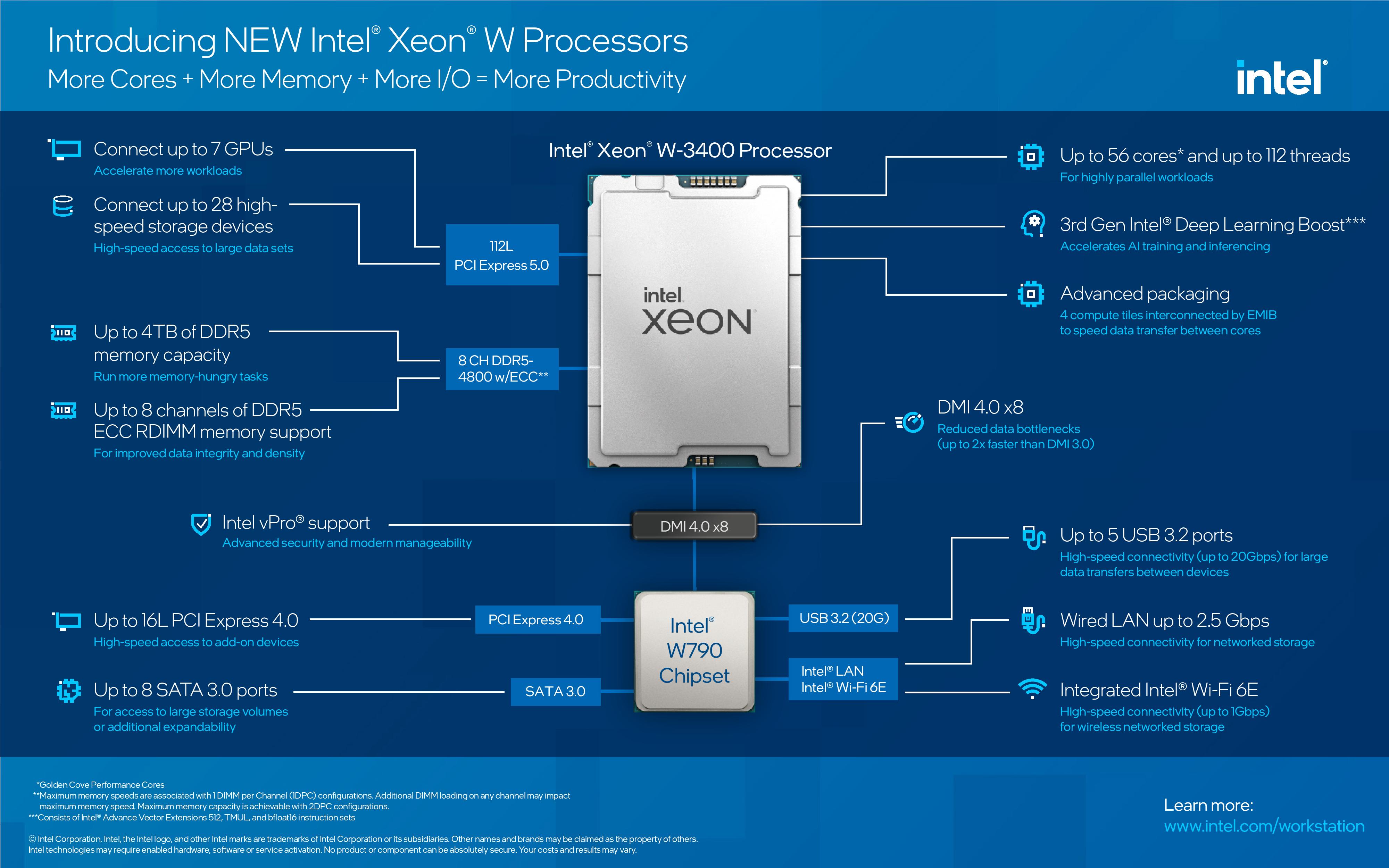
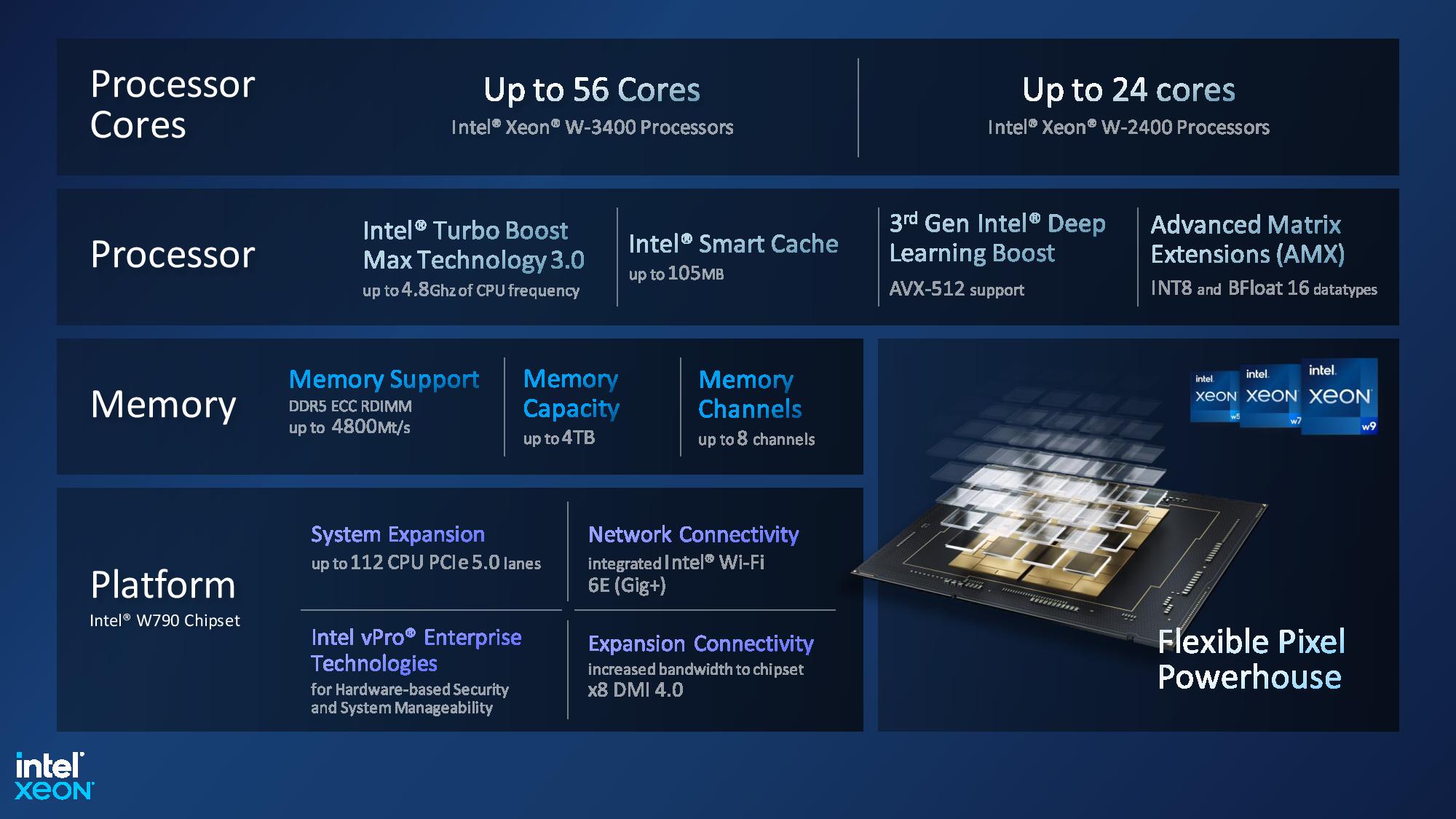


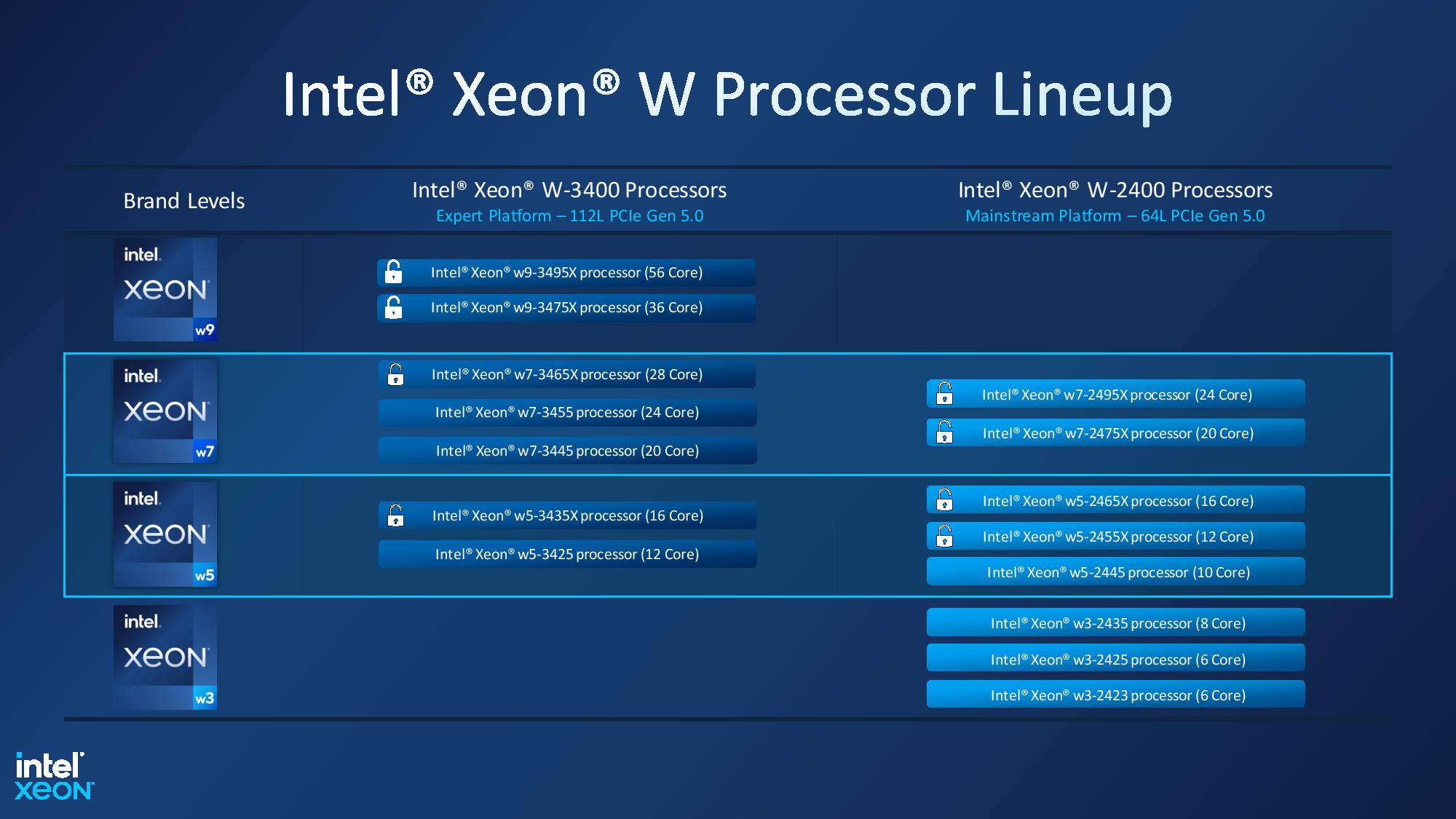
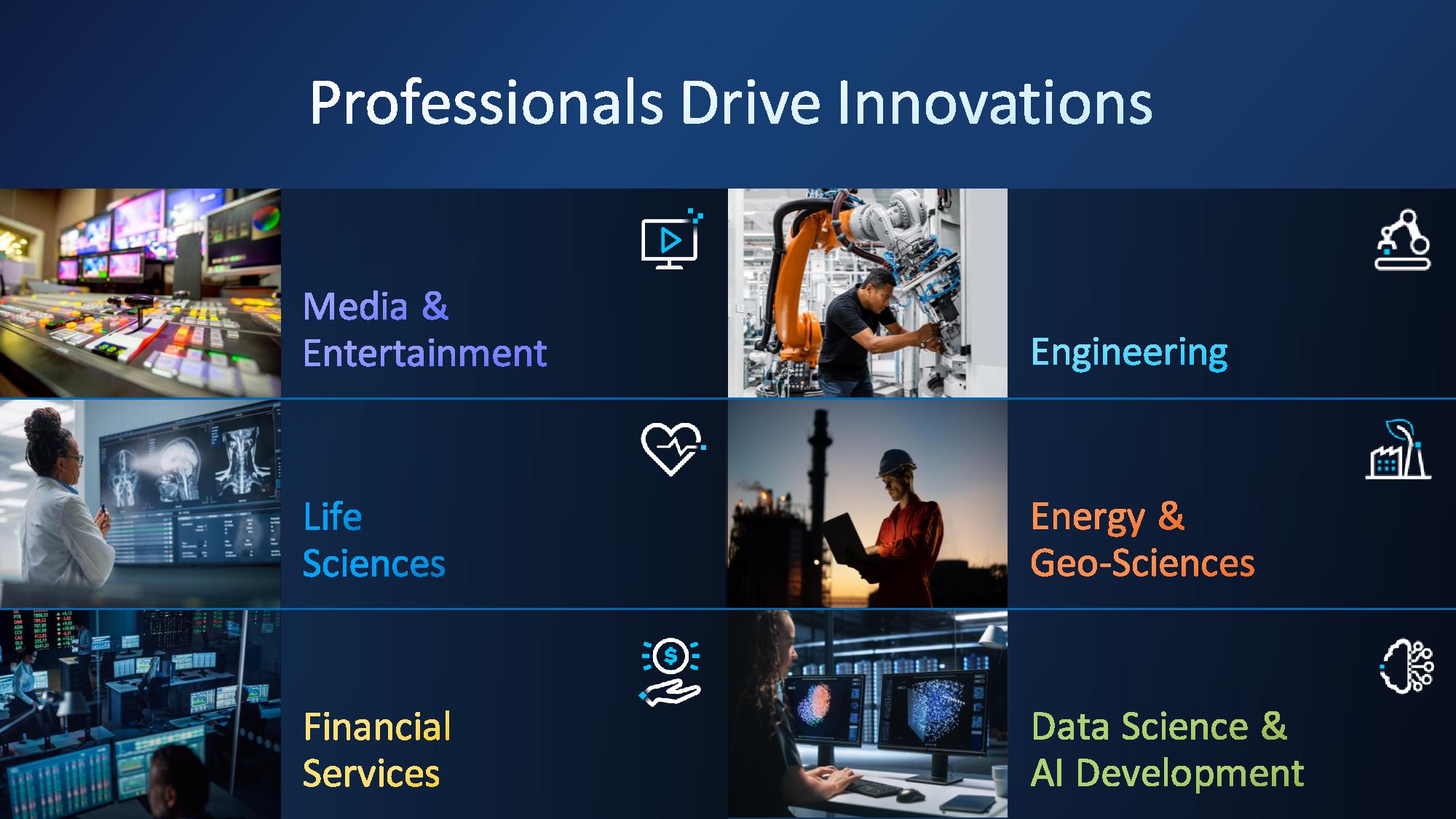




The Xeon W-3400 and W-3200 chips are designed for single-socket "Expert" and "Mainstream" platforms with the LGA-4677 socket and W790 chipset (generally the same as Z790), while the standard fourth-gen Intel Xeon Scalable processors with the same socket and the C741 chipset slot in for dual-socket workstations. Intel will not offer its HBM-equipped Xeon Max models for the workstation segment, and Optane memory is not supported for any of the workstation processors. However, all of the chips do support the CXL 1.1 interface (type 1 and 2 devices).
The W790 chipset provides 36 HSIO lanes, with 16 lanes of PCIe 4.0 exposed to the user to augment the PCIe 5.0 lanes that come directly from the CPU. The W-3400 and W-3200 chips both have a DMI 4.0 x8 connection between the CPU and the chipset to increase the amount of aggregate usable throughput from chipset-attached devices. The platform also supports many of the trimmings we'd expect from a modern platform, like eight SATA 3 ports, five USB 3.2, integrated LAN up to 2.5 Gbps, and WiFi 6E.
Intel's new chips can consume as much as 350W at their Processor Base Power, and 1.2X the PBO when under full load at their Maximum Turbo Power (MTP) rating. So powerful cooling systems are a must, particularly for higher-end chips. Intel has an ecosystem of partners ready with LGA-4677 cooling systems, like Cooler Master, EKWB, and Auras, with watercooled solutions for both custom loops and AIOs, along with Noctua with its air-cooled options.
On the motherboard front, we can expect W790 motherboards from the usual suspects, like ASRock, Gigabyte, Supermico, and ASUS.
Intel's chips also have all of the expected workstation-class RAS (reliability, availability, serviceability) features you'd expect, like support for ECC RDIMM memory and vPro. The Xeon W platform supports only RDIMMS and not UDIMMs, as the DDR5 spec now defines these two types with different pin-outs that require different physical layouts.
Intel Xeon W-3400 W-2400 Intel Benchmarks
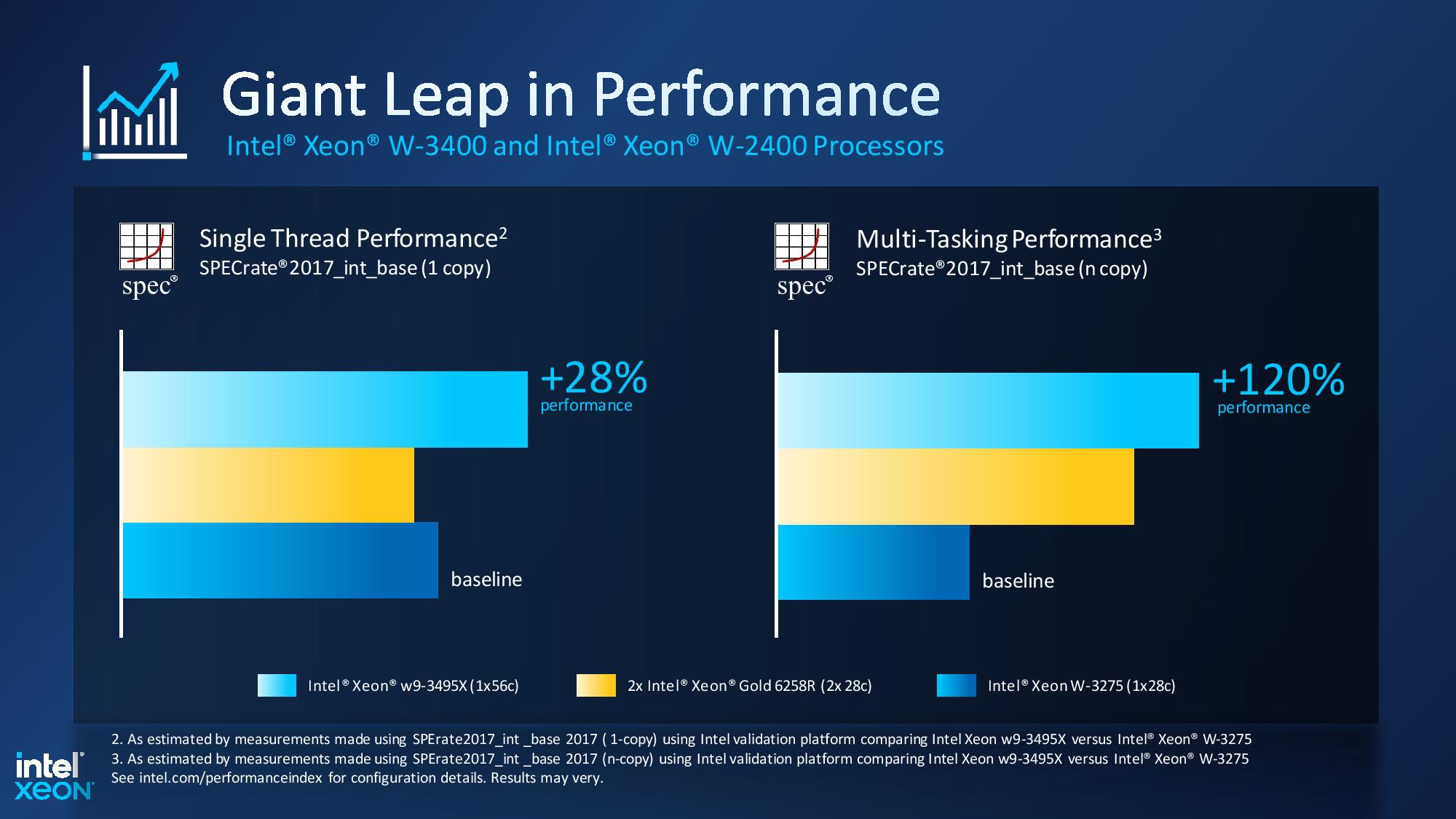
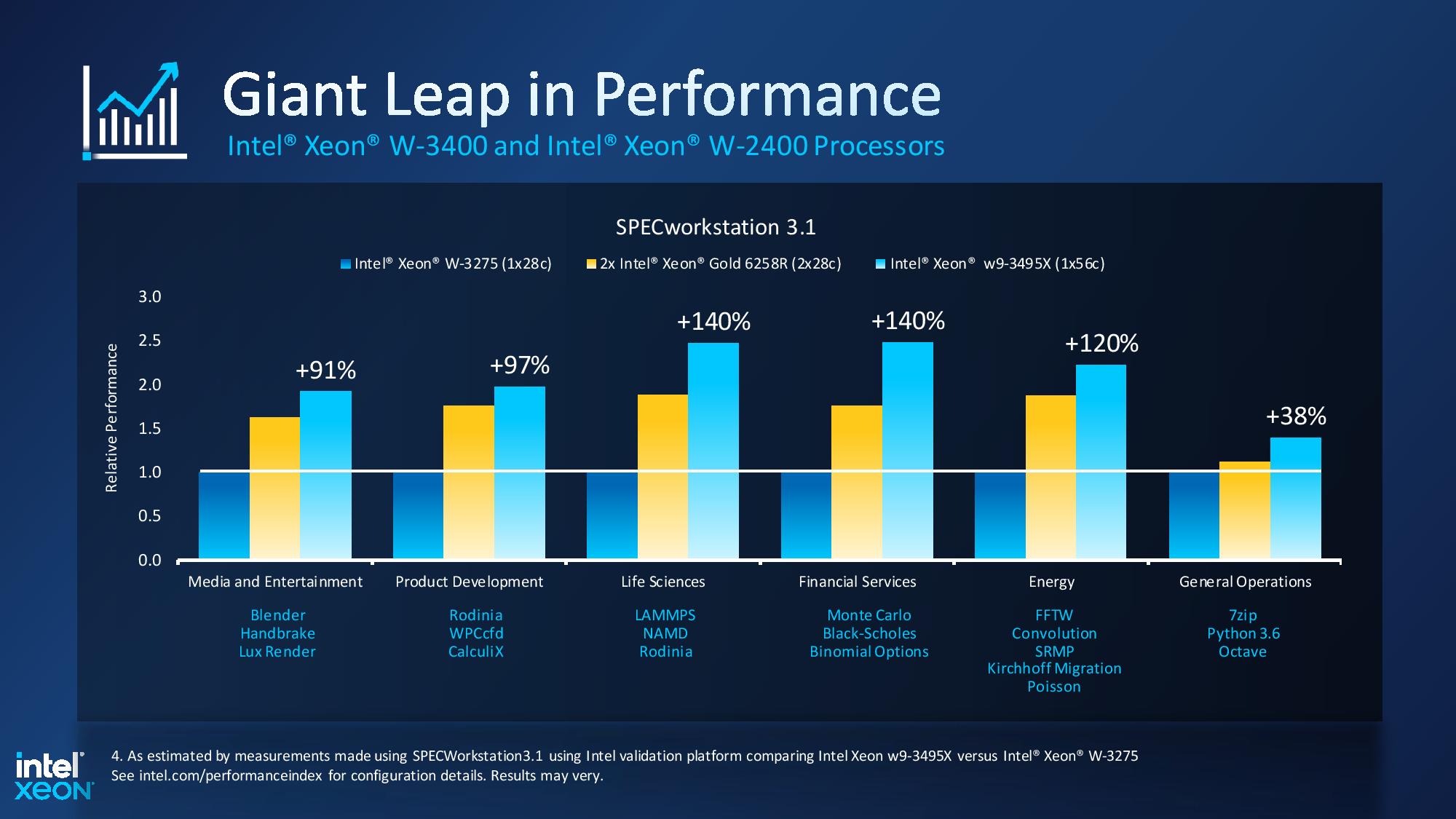



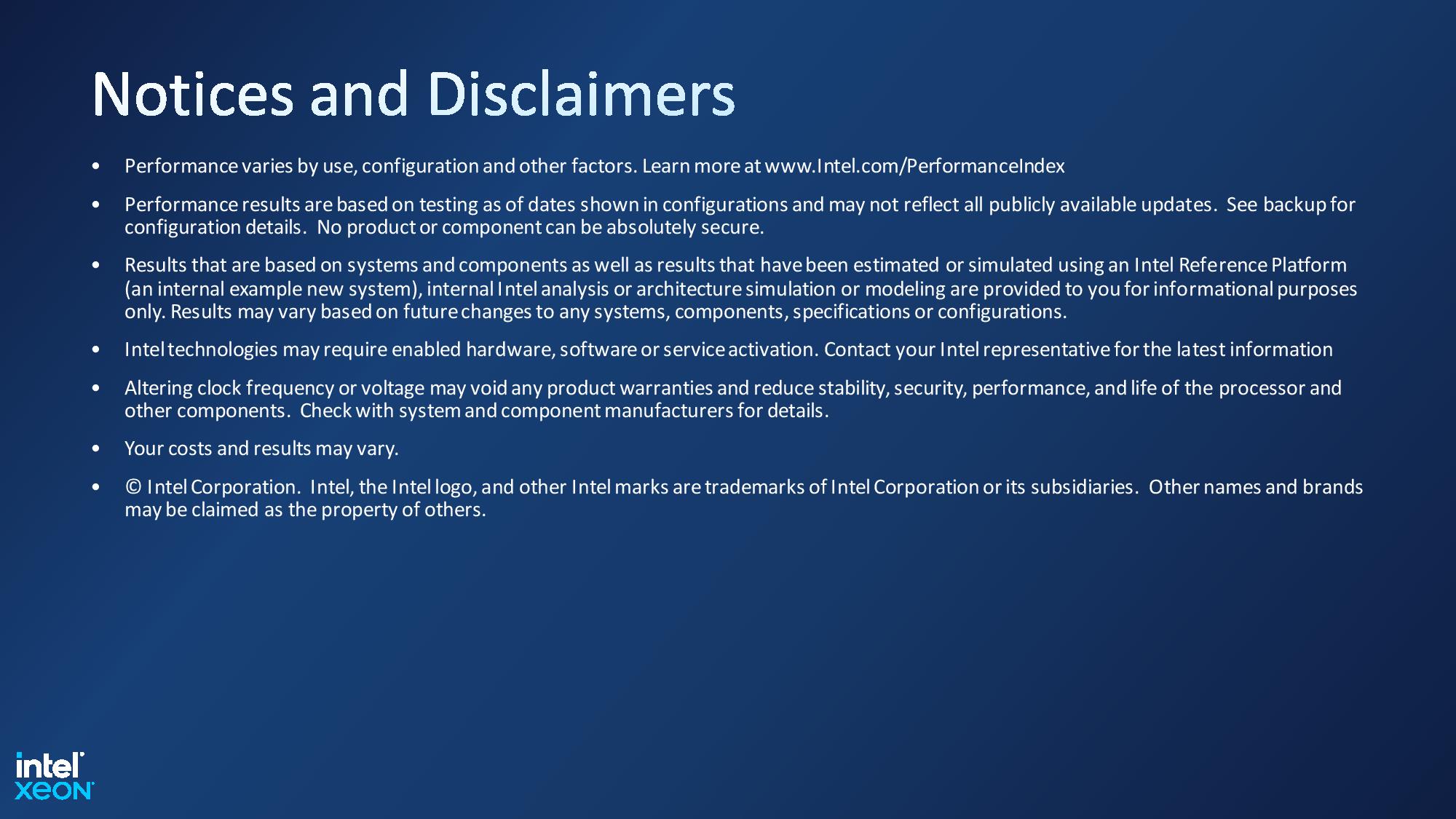
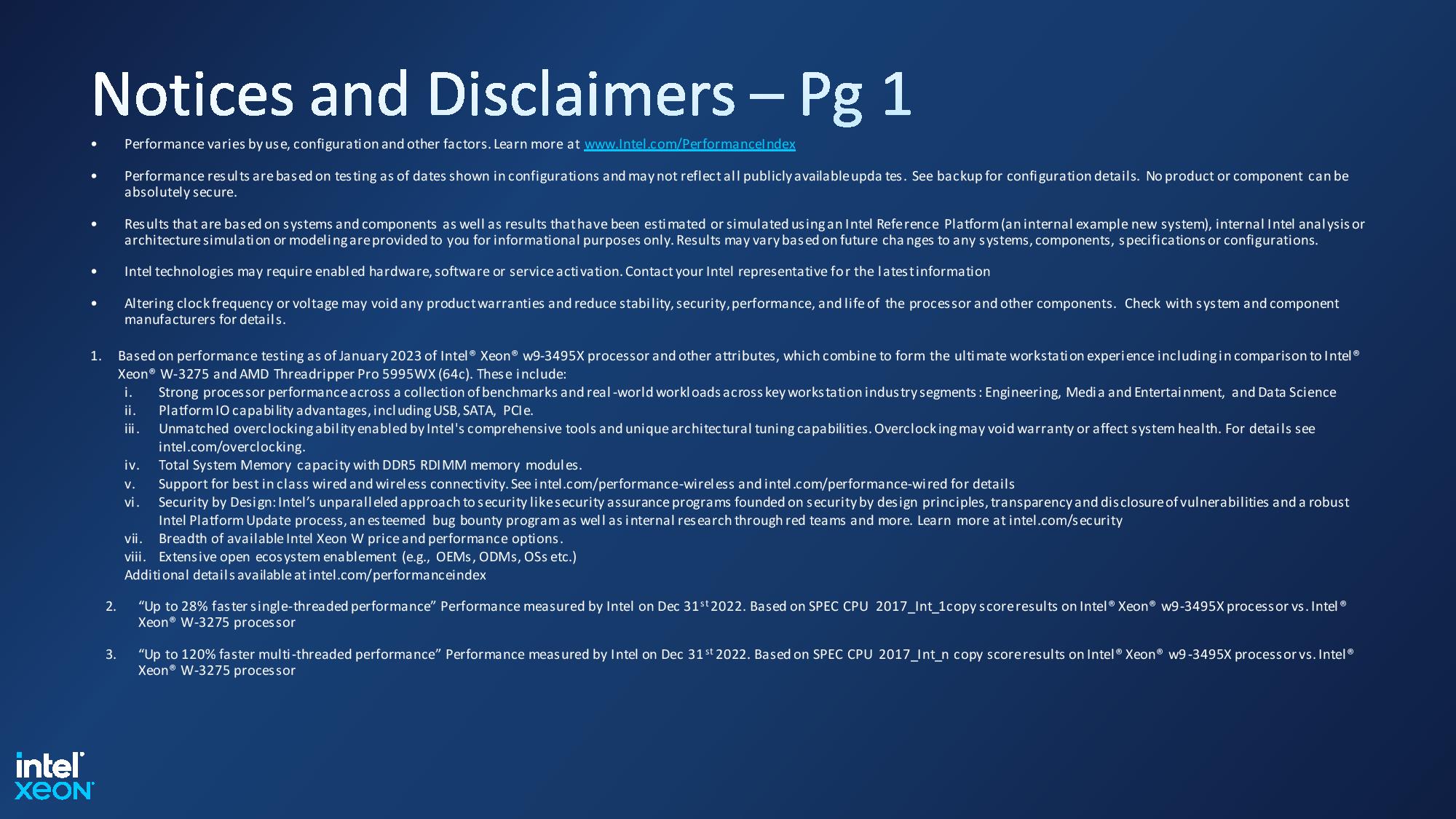
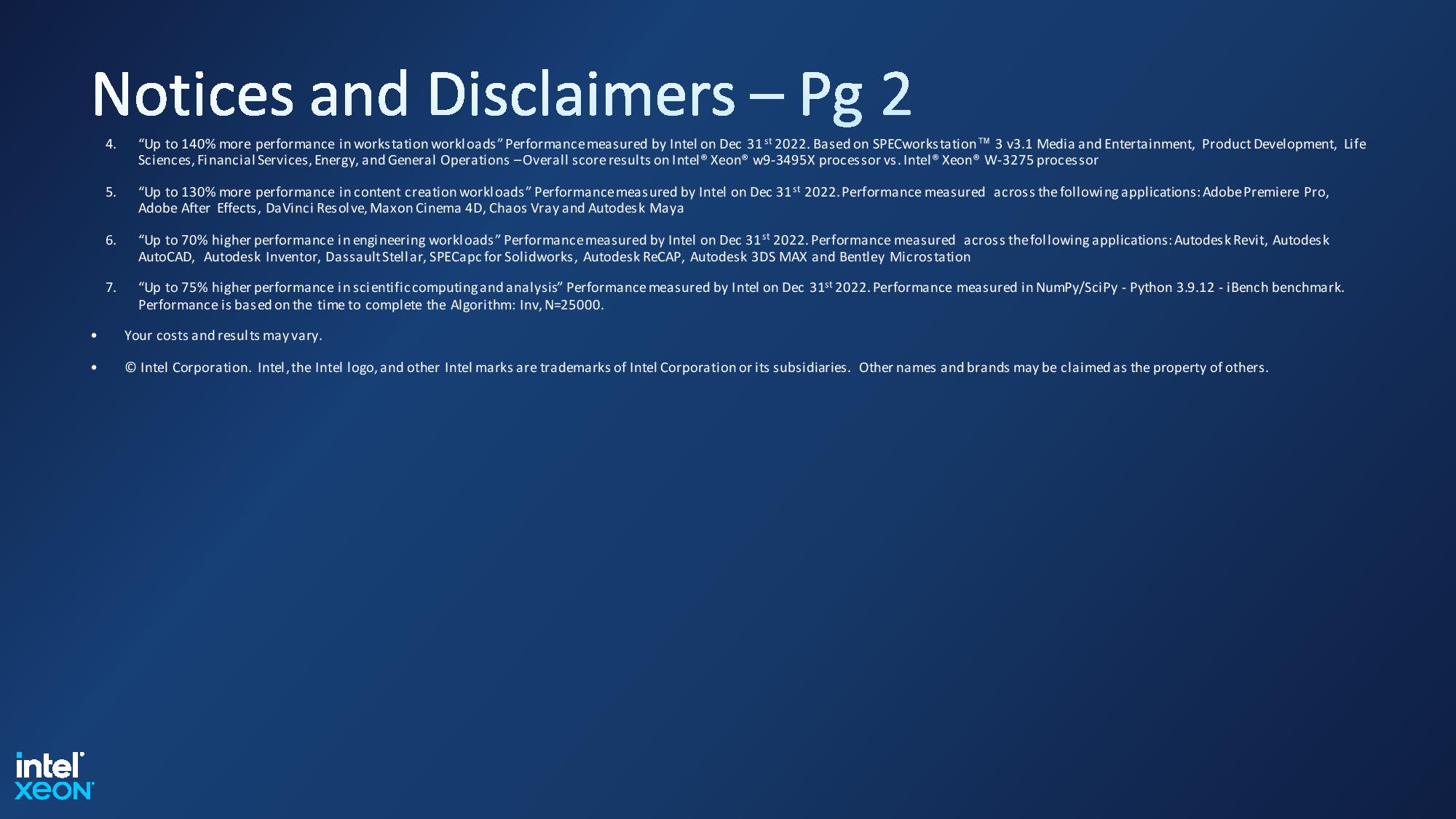
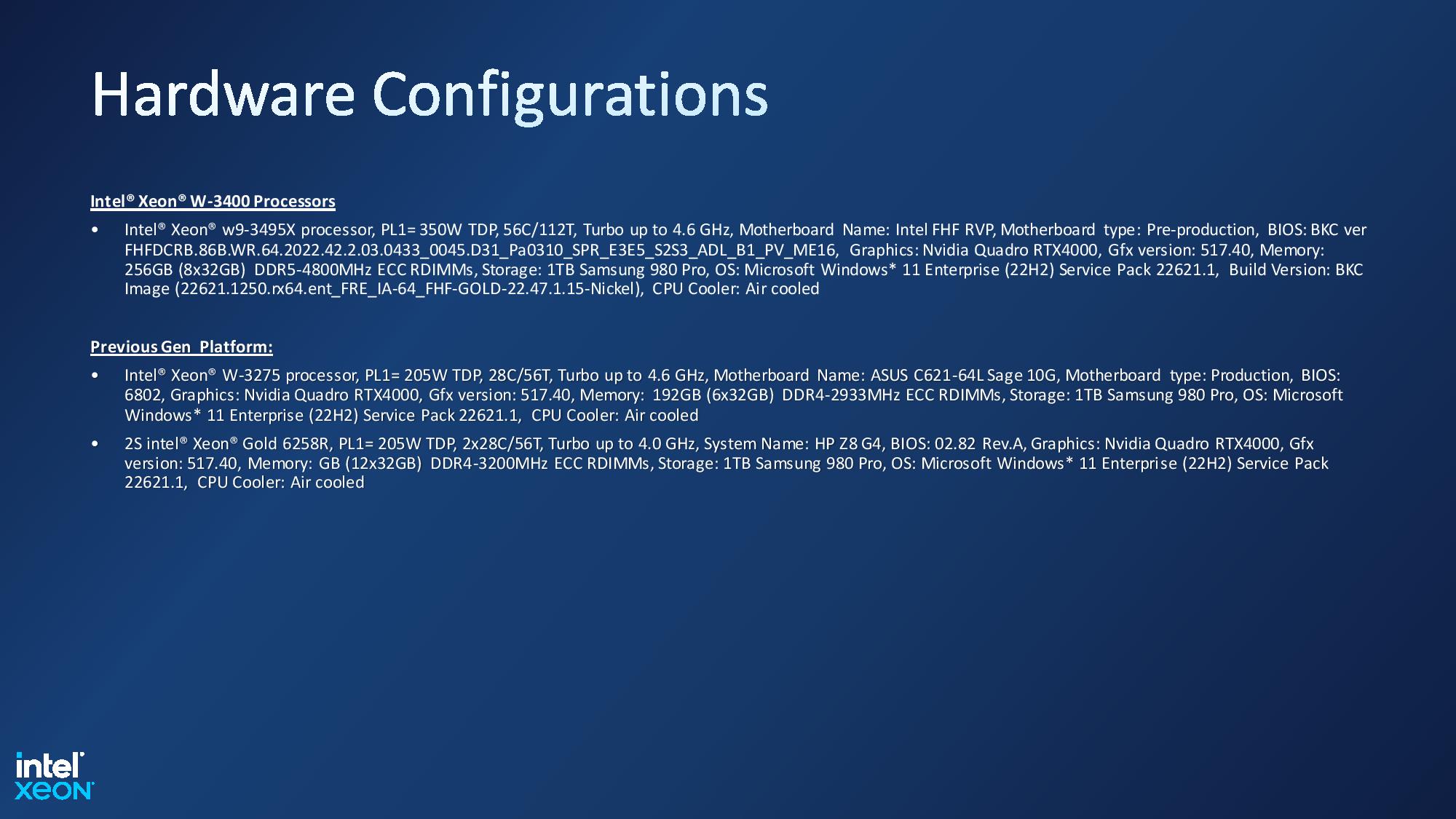


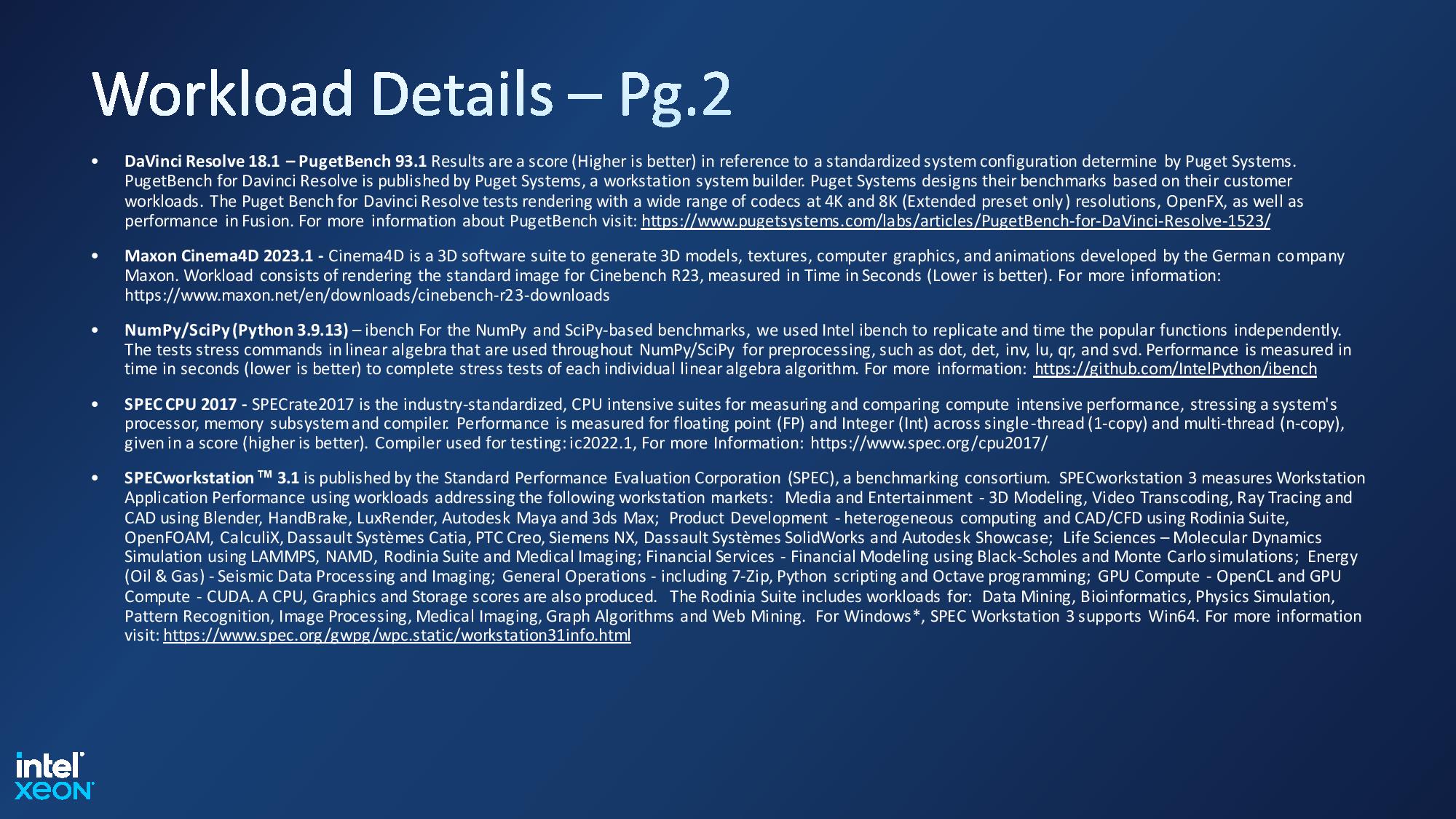

Intel shared some of its own internally-derived benchmarks, but as with all vendor-provided benchmarks, take them with a grain of salt. The test notes are at the end of the album.
Intel's benchmarks are all comprised of workstation-specific workloads, so the jury is out on how these chips will perform in gaming. Intel claims a 28% gen-on-gen gain in single-threaded and 120% more performance in multi-threaded work, as measured by SPECrate2017_int_base. Intel also shows solid performance gains in workloads in the SPECworkstation 3.1 benchmark, along with a broad selection of workstation-focused content creation and scientific workloads. Intel neglected to compare to its own previous-gen Xeon W-3300 series here, which is an interesting omission.
Intel says the Xeon W-3400 and W-2400 processors are available for preorder now from its partners, with full systems being available in March (Intel says there will be a total of 50+ system designs). We've already seen several listings for these chips at retail, so the boxed units might come earlier.
Get Tom's Hardware's best news and in-depth reviews, straight to your inbox.
- MORE: Best CPUs for Gaming
- MORE: CPU Benchmark Hierarchy
- MORE: AMD vs Intel

Paul Alcorn is the Editor-in-Chief for Tom's Hardware US. He also writes news and reviews on CPUs, storage, and enterprise hardware.
-
-Fran- These read good on paper, for sure. I specially like the w7-3455. Even if it is locked, I think it's a good middle ground to be had in the line up.Reply
That being said, I still think the floor is too high. The W motherboard are going to be expensive as well, so your minimum entry will be ~$4000 if you want to populate all 8 channels, at the minimum. This is assuming people buying these won't be populating them with regular DDR5 DIMMs (EDIT: I just realized they can't, LOL).
Also, this is not a return to HEDT as much as Intel just trying to fight AMD at the higher level. Otherwise, we'd see an X chipset for these and the return of the "X" class CPUs as well.
This is just Intel returning to the Workstation market to fight TR Pro.
Regards. -
Thunder64 LoL at the mention of gaming. Not everything is meant for gaming guys. And I think it's obvious why they don't allow BCLK adjustments.Reply -
kjfatl We could a few dozen Dual-Socket versions of this populated w/2 TB of DDR5 ECC RAM. (not a joke)..Reply
This product is not aimed at gamers but for targeted business applications. The more ram the merrier. We need at least 128GB/user and assume most users keep under 64GB. -
jp7189 Not the slam dunk I was hoping for. I'm definitely excited for the platform - tons of memory bandwidth and PCIe lanes, but I'm a little underwhelmed by the seeming price/performance of the CPUs themselves. We'll have to wait for independent benchmarks to know for sure.Reply -
hotaru251 Reply
"as the charts show the AMD alternative crushes our cpu even OC'd....but still buy ti as we have niche pcie 5.0 & ddr5"zecoeco said:Why don't they compare these against 5000 Threadripper Series? -
Vanderlindemedia ReplyIntel lists Processor Base Power (PBP), which is similar to the TDP rating, as stretching from 270W to 350W for the W-3400 series and 120W to 225W for the W-2400 series. These chips will consume more power under full load at their Maximum Turbo Power (MTP) rating, which is 1.2X the PBP. (For instance, the 350W model will peak at 420W, while the 300W model will reach 360W.)
I dont understand why intel cant get it right. Its peak power at 420W ~ 360W is quite more compared to a Threadripper or Epyc that lists their CPU at a maximum of 280W. -
thestryker Unless the motherboards tailored to the 2400 series are a fair bit cheaper than the ones for 3400 (I'm expecting these to be similarly priced to ICL Xeon W boards) it seems like the price of entry for the platform is going to be quite high. I was really hoping the 2455X would be in the $700-800 range as that would put it closer to the 7950/13900 in price. Instead what we got was Intel playing the same game as AMD started with TR 3000 and making the entry price very high. I get why they're doing it, and I expected it to happen, but it is still disappointing.Reply
I'm looking at the W680 platform to replace my old SNB Xeon server box a lot more seriously than before (was hoping for a lower core count 2400, but they're OEM only so availability will probably be a long ways out). I'm hoping there will be availability on the Asus PRO WS W680-ACE as it seems to have the configuration I need (it has has 2x m.2 and 2x PCIe x4 off the chipset) and the price is good.
Was hoping for the 2455X as a possible replacement for my current X99 setup, but it's looking like the price is just going to be too high so waiting for whatever comes next desktop wise and hoping to figure out a way around my PCIe lane usage. -
bit_user I'm annoyed they don't have a retail-boxed SKU for under $1k, but I don't really care because I can't really justify the expense of the CPU or the platform.Reply
I might have considered the 8 or 10 core model, depending on how much motherboards cost, but that's because I'm already planning to buy a $450 LGA1700 workstation board. If the board were within 1.5x of that price, I might've considered stepping up to the W-2435 or W-2445.
I'm also annoyed at how they limit the clocks of the models with fewer cores. That strikes me as entirely artificial. About a decade ago, it was the other way around - you'd actually get higher clocks on the models with fewer cores (even ones based on the same die). We don't need to go back to that, but it'd be nice to at least have parity.
